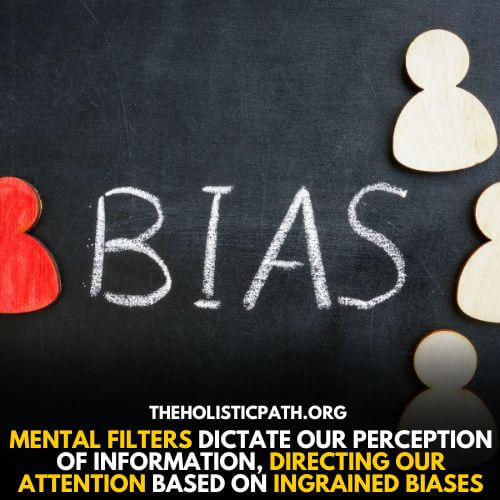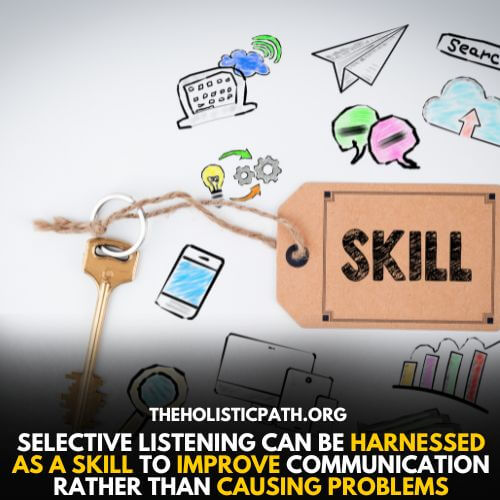Selective listening: an art or a skill? The ability to tune in and selectively absorb information is a powerful yet intricate facet of human interaction. It shapes our conversations, influences our responses, and often determines the course of our relationships.
This article delves deep into the curious world of selective listening, uncovering its subtleties and exploring its impact on communication dynamics. Join us as we unravel the secrets behind this nuanced practice and discover how it shapes our understanding of the world.
What is Selective Listening?
Selective listening is essentially the way our minds pick and choose what we focus on when someone is speaking. Think of it as wearing noise-canceling headphones – your brain tries to tune in to the most important bits while toning down the background noise. It’s like a superpower we all have, where we hone in on what matters to us while filtering out the rest.
This skill is used all the time in our lives, whether it’s during business meetings or casual chats at a crowded party. But this ability isn’t always a good thing. While it’s a key leadership skill and essential in professional settings, it can also lead to misunderstandings and missed information.
Selective Hearing vs. Selective Listening
Selective hearing is like the biological side of things, almost automatic, where our auditory attention naturally prioritizes some sounds over others (like when you hear your name at a busy place). Selective listening, however, is more intentional. It’s the mental filtering we do during conversations, deciding what we pay attention to and what we let slide.
Understanding this difference is important, especially in business settings where complete attention is crucial. It’s a bit like managing a ‘cocktail party effect,’ a phenomenon where, in a room full of noise and conversations, you focus on one particular conversation.
This ability to tune in and ignore distractions is a remarkable aspect of our listening capacity. However, this selective behavior can sometimes act as a barrier to effective communication, causing issues in various situations, from personal relationships to professional environments.
Balancing this skill of selective listening is essential.
Selective Listening in Communication Examples
Selective listening in communication is a common phenomenon that can be illustrated through various everyday examples. Here are a few effective and accurate examples to help clarify the concept:
- In a Business Meeting: Imagine a team meeting where your boss is giving a detailed presentation. While you’re trying to pay attention to the key points, you can’t help but focus on your own thoughts and to-do list. You’re selectively listening to the parts of the presentation that directly relate to your tasks, but you’re missing out on the broader context, which could be crucial for understanding the company’s strategy.
- During a Heated Argument: When disagreeing with a friend, you might be so fixated on making your point that you selectively listen to their arguments to find weaknesses to attack, rather than genuinely understanding their perspective. In this case, you’re filtering out information that doesn’t support your position.
- At a Social Gathering: Picture a lively cocktail party with multiple conversations happening at once. You find it challenging to concentrate on one discussion with a friend because of the surrounding noise. As you talk, you’re selectively listening to your friend’s voice and what they’re saying, while unintentionally blocking out other conversations. This is the ‘cocktail party effect’ in action.
- In a Classroom: Students may engage in selective listening during lectures. They might focus on the topics they find interesting or consider important while tuning out the rest. For example, in a history class, a student might listen attentively when the teacher talks about a subject they enjoy but tune out when the topic shifts to something they find less engaging.
4 Tell-A-Tale Signs of a Selective Listener
In interpersonal communication, identifying signs of selective listening can greatly impact the quality of understanding and engagement. Below are key indicators to recognize if someone might be a selective listener.
| Signs of Selective Listening | Explanation |
|---|---|
| Juggling Multiple Conversations | Difficulty in focusing on a single conversation or piece of information due to distractions from multiple stimuli, hindering effective focused listening. |
| Mental Preoccupation | Struggling to concentrate due to preoccupation with personal thoughts, which can hinder active listening and understanding. This can also result from various issues or conditions, such as ADHD. |
| Interrupting Without Full Comprehension | Tendency to interrupt before understanding the speaker’s complete message, leading to misinterpretation and breakdowns in communication. |
| Challenges in Business Settings | Difficulty in maintaining undivided attention during crucial business meetings, hindering effective communication and leadership skills. |
Recognizing these signs can aid in addressing barriers to effective listening and communication, facilitating more meaningful and comprehensive interactions, particularly in professional environments where attentive listening and understanding are paramount.
5 Types of Selective Listening
Yes, there are different types of selective listening, each with its distinct characteristics and impact on communication. Here are a few types of selective listening:
- Defensive Listening: This type involves individuals listening primarily to defend or protect their perspectives or beliefs. They filter out information that challenges their existing views and might only focus on points that confirm their opinions. Defensive listeners often disregard alternative ideas or criticisms, leading to communication barriers and potential misunderstandings.
- Selective Ignoring: Selective ignoring occurs when individuals consciously or subconsciously tune out certain information. It may be a deliberate choice to avoid specific topics or details that are uncomfortable or deemed irrelevant. This type of selective listening can result in missed information and might hinder a comprehensive understanding of a situation.
- Egotistical Listening: Egotistical listeners tend to focus on topics that directly concern them or reflect their interests, often steering conversations toward their experiences or opinions. They prioritize their own stories or perspectives, making the conversation revolve around their concerns, potentially overshadowing the needs or contributions of others.
- Judgmental Listening: Judgmental listening involves assessing and categorizing information based on preconceived notions or biases. Listeners might quickly form opinions without fully comprehending the speaker’s message. This type of selective listening can lead to misinterpretation or a failure to grasp the complete context of what is being communicated.
- Superficial Listening: Superficial listeners grasp only the surface-level information without delving deeper into the underlying meaning or implications. They might absorb the basic details but fail to comprehend the nuances or emotions behind the message, resulting in a lack of complete understanding.
These types of selective listening behaviors often influence how individuals engage in conversations and process information. Recognizing these patterns can help individuals work towards more open, attentive, and comprehensive listening habits, fostering better communication and understanding in various interpersonal and professional settings.
10 Unavoidable Dangers of Selective Listening
selective listening, while a natural cognitive process, can present several dangers and challenges in various aspects of life, especially in professional settings. Here’s an explanation of the dangers of selective listening along with a table for better clarity:
| Danger | Explanation |
|---|---|
| Misunderstandings | Selective listening leads to missing crucial details, resulting in frequent misunderstandings and incomplete comprehension. |
| Communication Breakdown | It creates barriers to effective communication by prioritizing certain information and disregarding others, hindering open dialogue and collaboration. |
| Conflict and Tension | Selective listening amplifies conflicts as it often dismisses opposing viewpoints, leading to increased tension in relationships. |
| Ineffective Decision-Making | The inability to absorb all relevant information leads to poor decisions, especially in professional settings, impacting leadership and overall efficiency. |
| Reduced Productivity | Focusing only on specific information can lead to neglect of other important tasks, diminishing overall productivity. |
| Loss of Opportunities | Missing out on valuable opportunities due to neglecting information that might be crucial for personal or professional growth. |
| Weakened Relationships | Selective listening can strain relationships due to the lack of complete attention and empathy, potentially eroding trust and connection. |
| Failure to Adapt | Difficulty in adapting to changing circumstances or new information due to focusing on specific aspects. |
| Overlooking Critical Information | Dismissing crucial information can result in missed opportunities and incomplete understanding in various contexts. |
| Impairment of Selective Listening Skills | Continuously engaging in selective listening reinforces the habit, hindering the development of effective listening skills, particularly impacting relationships. |
Improving Selective Listening for Enhanced Communication: 5 Best Ways
Selective listening can be harnessed as a skill to improve communication rather than causing problems. Developing selective listening skills is crucial, especially in professional settings where complete attention and effective communication are essential for success.
Below are key strategies to enhance selective listening skills:
1. Active Engagement Through Focused Listening
Focused listening isn’t merely about hearing; it’s about actively participating in the communication process. Engaging with the speaker involves not just hearing the words but deciphering the emotions and nuances underlying the message.
Beyond avoiding distractions, it necessitates being present and attuned to the speaker’s verbal and non-verbal cues.
Techniques like maintaining consistent eye contact convey your attentiveness and interest while paraphrasing the speaker’s points demonstrates your understanding. Additionally, asking clarifying questions not only aids in a comprehensive understanding of the message but also indicates an active involvement and desire to truly comprehend the speaker’s intent.
This level of active engagement establishes a deeper connection and fosters more effective communication.
2. Overcoming Mental Filtering for Open-Mindedness
Mental filters often dictate our perception of information, directing our attention based on ingrained biases.
To cultivate more open-minded selective listening, challenging these biases becomes essential. Actively seeking out and considering viewpoints that diverge from our own helps broaden our understanding and allows for a more diverse range of information to be absorbed.
It’s vital to consciously set aside assumptions and preconceptions, embracing a more inclusive approach to understanding various perspectives. Open-mindedness enables a richer interpretation of information and allows for a more comprehensive grasp of the diverse range of views presented in a conversation.

3. Strengthening Auditory Attention Skills
Improving auditory attention involves not just hearing, but actively focusing on specific sounds or conversations. To enhance this skill, deliberate practice in concentrating on a single voice amidst a crowded room or during bustling business meetings is beneficial.
Techniques such as summarizing or restating what you’ve heard help reinforce your understanding and retention of the speaker’s message. Additionally, cultivating the ability to discern nuances in tone and inflection aids in more accurately interpreting the speaker’s intentions, fostering a more comprehensive understanding of the communicated message.
4. Adapting to Professional Settings for Better Communication
Navigating professional settings demands a tailored approach to listening. In meetings or other professional contexts, it’s crucial to focus on key points while simultaneously being attentive to non-verbal cues and contextual elements.
This nuanced approach ensures a holistic understanding of the message conveyed.
Adapting your listening approach allows for more accurate interpretation and a deeper understanding of the message within the professional environment. Being receptive not just to the words spoken, but to the subtleties in body language and overall context enhances the efficacy of communication within these settings.
5. Asking Questions
Asking questions plays a vital role in improving selective listening skills, as it not only demonstrates active engagement but also fosters a deeper understanding of the message being communicated. Here is how you can ask questions to show that you are taking the conversation seriously:
- Clarification: Request specific details for a better grasp of the message.
- Open-Ended Queries: Encourage comprehensive responses for a fuller understanding.
- Reflection: Mirror the speaker’s thoughts, showing empathy and understanding.
- Context Probing: Inquire about the background to comprehend motivations.
- Empathetic Inquiry: Understand the emotional tone for effective communication.
Final Thoughts
Selective listening is a dynamic aspect of communication that demands our conscious attention. It can be both a valuable asset and a potential hazard, depending on how we wield it. When approached with active engagement, an open mind, and empathy, selective listening becomes a powerful tool for deepening understanding and improving connections. However, when used indiscriminately or recklessly, it can lead to misunderstandings and strained relationships. Striking a balance is the key, where selective listening complements complete understanding, nurturing effective communication and stronger bonds in all aspects of life.
Frequently Asked Questions
What Are The Benefits Of Selective Listening?
Selective listening offers several advantages. It enables individuals to focus on important information, enhancing comprehension and memory retention. It helps in managing information overload, and improving efficiency, and decision-making, especially in professional settings. Moreover, it aids in maintaining attention amidst distractions, contributing to effective interpersonal communication and fostering more meaningful conversations.
Can Selective Listening Be A Good Thing In Certain Situations?
Yes, selective listening can be beneficial in specific scenarios. For example, in crowded or noisy environments like social gatherings, the ability to selectively listen allows individuals to concentrate on one conversation amid multiple discussions, a phenomenon often referred to as the “cocktail party effect.” In situations where focusing on specific details or information is necessary, selective listening proves advantageous.
Is Selective Listening Always Intentional Or Can It Be Unconscious?
Selective listening can occur both consciously and unconsciously. While intentional selective listening involves actively choosing what to pay attention to, unconscious selective listening can be influenced by various factors such as personal preferences, biases, or external distractions. In some cases, individuals may involuntarily tune into specific sounds or information due to their inherent nature or external stimuli.
How Does Selective Listening Affect The Listener’s Own Understanding Of The Conversation?
Selective listening impacts the listener’s comprehension by focusing their attention on specific information while filtering out other details. This can either enhance understanding by concentrating on key points or hinder comprehension by missing crucial information. The listener’s understanding is shaped by what they choose to concentrate on, potentially affecting the depth and accuracy of their comprehension.
Are There Any Physical Or Psychological Factors That Contribute To Selective Listening?
Numerous physical and psychological factors contribute to selective listening. Physically, the auditory cortex and attention mechanisms play a role in how individuals focus on specific sounds or conversations. Psychologically, factors like biases, individual interests, emotional relevance, and cognitive processes influence what information is deemed significant. Additionally, conditions such as attention-deficit hyperactivity disorder (ADHD) may also affect selective listening tendencies.


